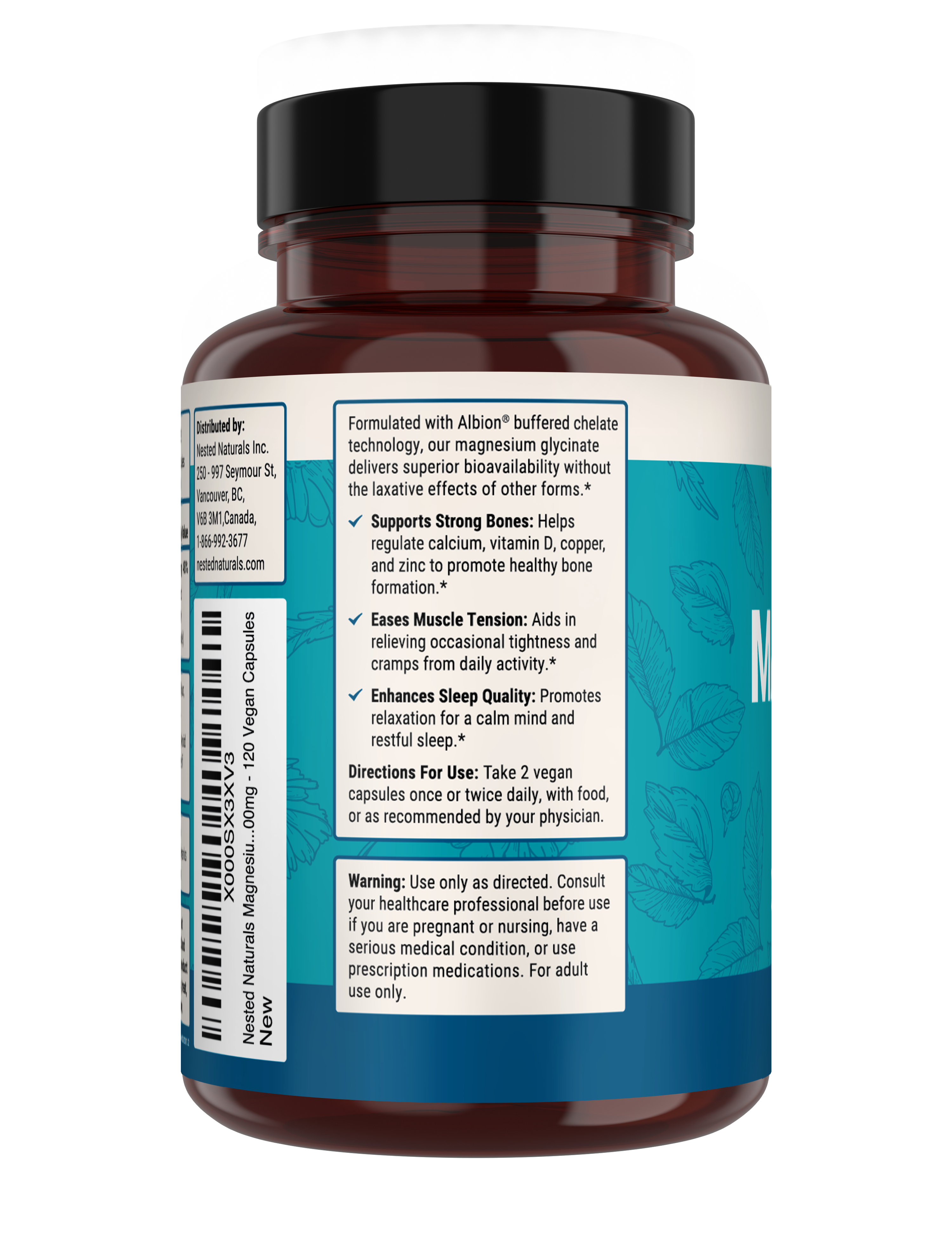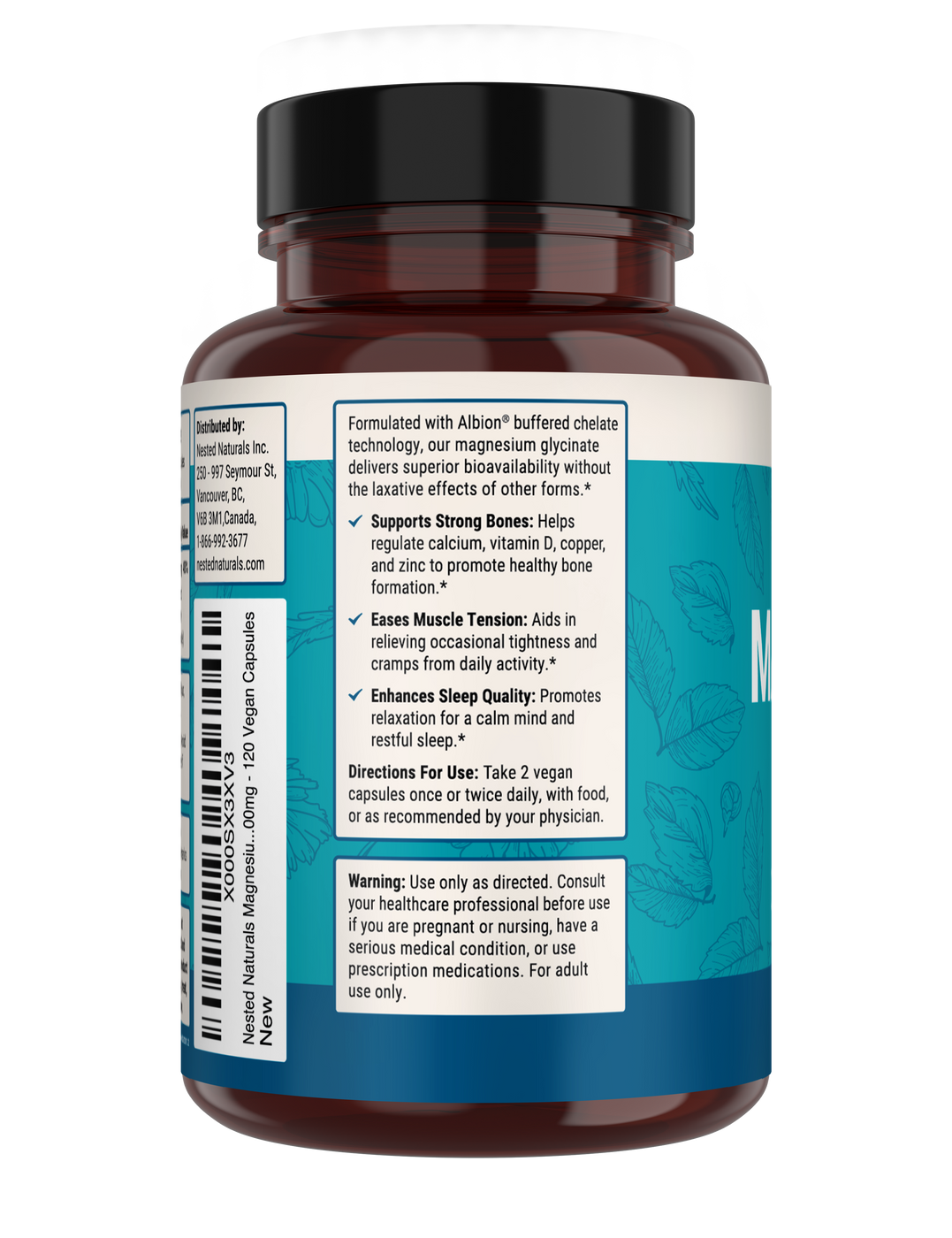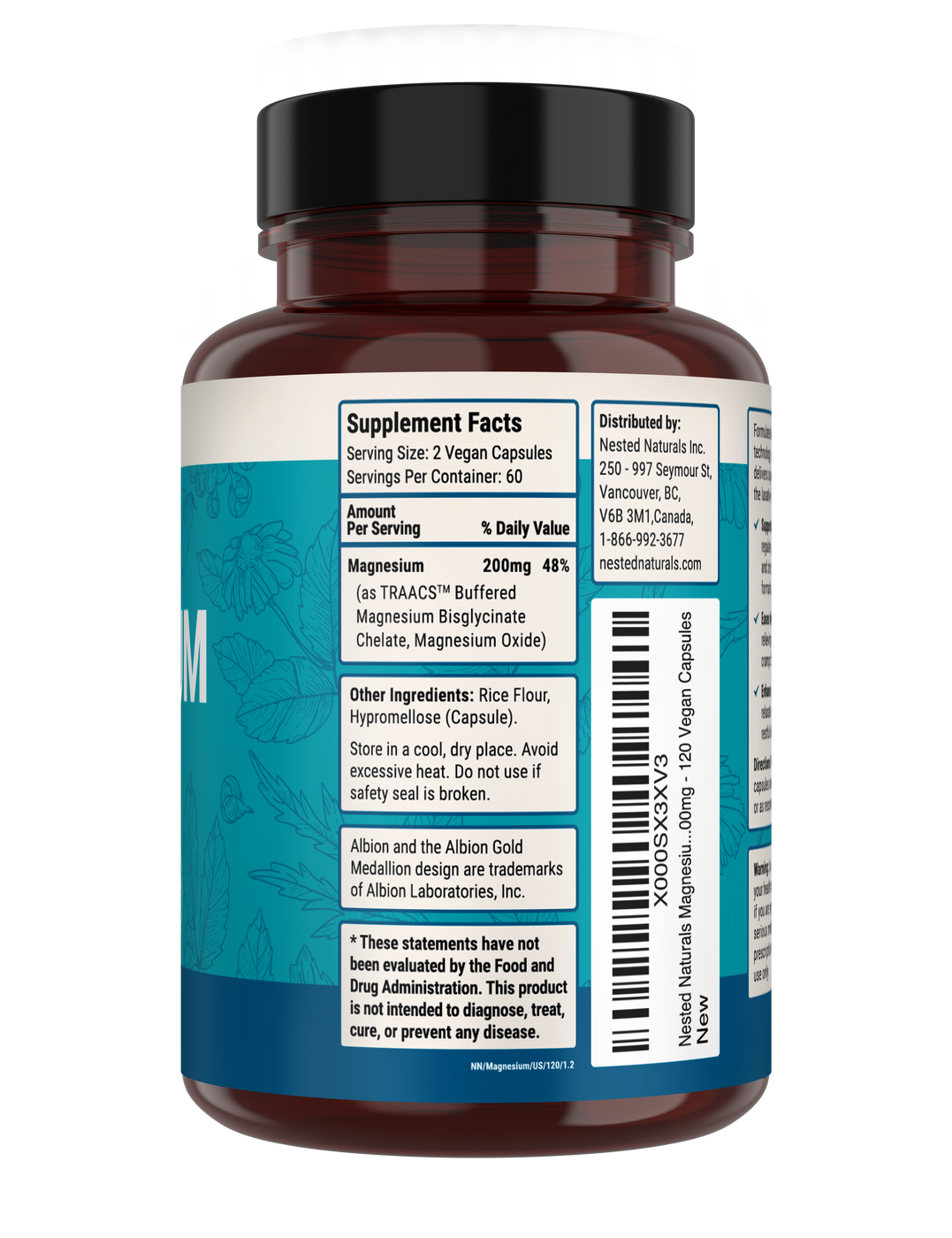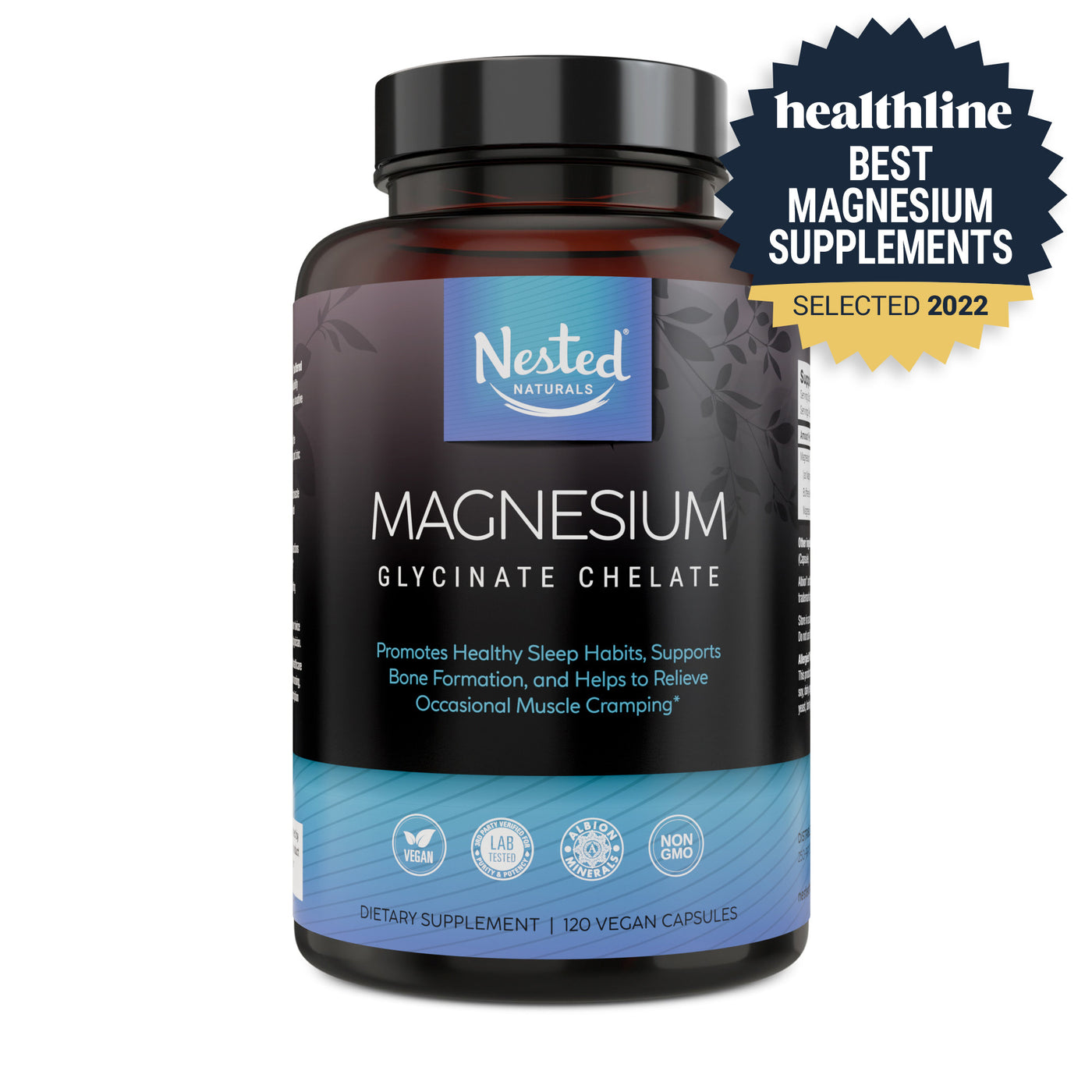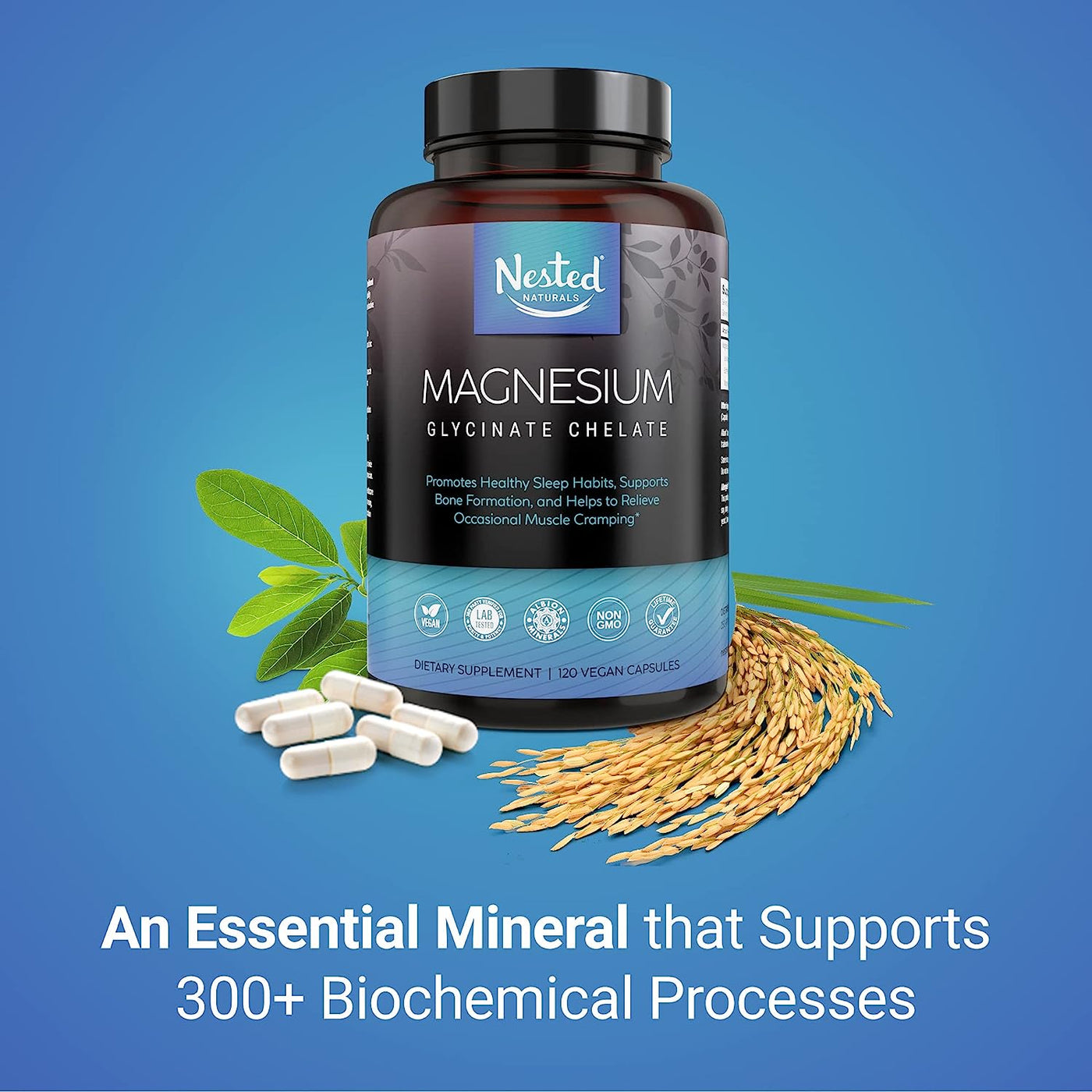"Magnesium Glycinate Chelate: Your Natural Sleep Supplement of Choice, with No Worries about 'Does Magnesium Glycinate Cause Dry Mouth?'"
"Discover the best magnesium glycinate supplement brand for a restful night's sleep without the worry of dry mouth – Magnesium Glycinate Chelate, your natural sleep solution."
Explore the benefits of our Magnesium Glycinate Chelate, a natural sleep supplement. Discover if chelated magnesium side effects include dry mouth.
"Discover the restful benefits of Designs for Health Magnesium Glycinate Complex, a natural sleep supplement, while addressing common concerns like 'does magnesium glycinate cause dry mouth?'"
"Wondering about magnesium chelate side effects? Discover if dry mouth is a concern when using Magnesium Glycinate Chelate, your natural sleep supplement."
"Magnesium Glycinate Chelate, a natural sleep supplement, is often a preferred choice for those concerned about potential dry mouth side effects, making it a suitable option, especially for individuals searching for 'magnesium glycinate for allergies'."
Experience restful nights and relief from nerve pain with our premium Magnesium Glycinate Chelate, the natural sleep supplement trusted by those seeking relief through magnesium glycinate for nerve pain.
"Discover the soothing benefits of Magnesium Glycinate Chelate, a natural sleep supplement, without worrying about dry mouth, as it won't affect your dietary magnesium intake."
"Taking magnesium glycinate as a natural sleep supplement: Does it lead to dry mouth?"
Experience the benefits of our Natural Sleep Supplement, powered by the definitive magnesium glycinate chelate complex for improved sleep and overall well-being.
Curious about what does magnesium glycinate do? Discover its role in our Natural Sleep Supplement, where it promotes better sleep and overall well-being through its unique chelate formulation.
Wondering, Can I open magnesium glycinate capsules? Yes, you can with our Natural Sleep Supplement, making it easy to customize your dosage for improved sleep and overall well-being.
Elevate your sleep quality and overall well being with our Magnesium Glycinate Chelate, the definitive choice for those seeking the benefits of magnesium gly in a natural sleep supplement.
Looking to enhance your sleep naturally? Find the answer to Where can I buy magnesium glycinate? right here with our Natural Sleep Supplement featuring Magnesium Glycinate Chelate.
does magnesium glycinate have calories Wondering about your calorie intake? Rest assured, our Magnesium Glycinate Chelate in this Natural Sleep Supplement is calorie-free. So, no need to worry about Does magnesium glycinate have calories? while you improve your sleep quality.
Luma Nutrition BBB: When it comes to trust and quality, Luma Nutrition proudly holds the definitive BBB accreditation, ensuring the excellence of our Magnesium Glycinate Chelate in this Natural Sleep Supplement.
Experience restful nights naturally with our Magnesium Glycinate Chelate, expertly formulated as a natural sleep supplement, enriched with magnesium gluconate for anxiety relief, brought to you by Nested Naturals.
Discover peaceful sleep with our Magnesium Glycinate Chelate, a natural sleep supplement that offers the benefits of magnesium without laxative effect, thoughtfully crafted by Nested Naturals.
Unlock restful sleep with the purity of whole foods magnesium glycinate in our Natural Sleep Supplement, brought to you by Nested Naturals.
Tailored for your convenience, our Natural Sleep Supplement featuring Magnesium Glycinate Chelate offers flexibility—yes, you can you open magnesium glycinate capsules if desired. Experience the thoughtful design by Nested Naturals.
Prioritize restful nights and digestive ease with our Natural Sleep Supplement, incorporating magnesium glycinate and bowel movements—another thoughtful aspect of Nested Naturals' formula.
Experience the convenience you crave with our Natural Sleep Supplement, where you have the option to open magnesium glycinate capsules, tailored to your preference by Nested Naturals.
Discover the ultimate in relaxation and sleep support with our Natural Sleep Supplement, available in convenient magnesium tablets, thoughtfully created by Nested Naturals.
Experience tranquility throughout the night with our Natural Sleep Supplement's advanced formula, available in extended release tablets, carefully designed by Nested Naturals.
Elevate your sleep routine by taking magnesium supplements with our Natural Sleep Supplement, featuring Magnesium Glycinate Chelate—a thoughtful choice from Nested Naturals for restful nights.
Discover the ultimate relaxation with our Magnesium Glycinate Chelate, the natural sleep supplement that offers the benefits of magnesium glycinate healthy options for a restful night's sleep.
Enhance your sleep naturally with our Magnesium Glycinate Chelate, the premium choice for a peaceful night's rest and the best place to buy magnesium glycinate for your wellness journey.
Experience the benefits of a peaceful sleep with our Magnesium Glycinate Chelate, now available in a convenient and delicious form as chewable magnesium glycinate tablets.
Elevate your sleep routine with our Magnesium Glycinate Chelate, the natural sleep supplement that embodies the essence of healthy options magnesium glycinate for your holistic well-being.
Unlock peaceful nights with our Magnesium Glycinate Chelate, the natural sleep supplement crafted to perfection. Wondering, 'Is 200mg magnesium enough?' Discover the answer within every soothing dose.
Induce tranquility with our Magnesium Glycinate Chelate, the natural sleep supplement designed to help you unwind. Experience the soothing effects of magnesium glycinate capsules for a restful slumber.
Discover the path to rejuvenating sleep with our Magnesium Glycinate Chelate, the natural sleep supplement perfected for your relaxation. Experience the benefits of high absorption magnesium glycinate for truly restful nights.
Magnesium Glycinate Muscle Relaxant Magnesium Glycinate Chelate, a natural sleep supplement, acts as a definite muscle relaxant due to its unique properties.
Magnesium glycinate chelate is a natural sleep supplement with exceptional benefits, suitable for both adults and kids, making "kids magnesium glycinate" an ideal choice for a restful night's sleep.
Experience better sleep with our natural sleep supplement, featuring a powerful magnesium 200 mg chelated blend in the form of Magnesium Glycinate Chelate.
Experience restful nights with the natural sleep supplement, Magnesium Glycinate Chelate, enriched with a powerful magnesium chelated blend.
Magnesium Glycinate Chelate, a natural sleep supplement, offers superior absorption and effectiveness compared to magnesium oxide supplements.
Discover better sleep with Magnesium Glycinate Chelate, the natural sleep supplement known for its effectiveness in promoting restful nights through magnesium glycinate supplementation.
Magnesium Glycinate Chelate is a natural sleep supplement that stands out as the definite cheapest magnesium supplement for a restful night's sleep.
Experience restful nights with our Magnesium Glycinate Chelate, a natural sleep supplement containing the perfect dose of magnesium glycinate 75 mg, carefully formulated to promote peaceful and rejuvenating sleep.
Unlock the power of peaceful slumber with our Magnesium Glycinate Chelate, the ultimate natural sleep supplement designed to be taken with confidence as magnesium glycinate at night, ensuring a restful and revitalizing sleep experience.
Embrace serene nights with our Magnesium Glycinate Chelate, a top-tier natural sleep supplement that excludes magnesium sulfate for sleep, providing you with a safe and effective solution to promote deep and uninterrupted rest.
Discover the answer to why take Magnesium Glycinate? in our all-natural sleep supplement, where the potent combination of essential minerals and advanced chelation technology ensures a restorative slumber and a refreshed morning.
Unveil the science of blissful sleep with our Magnesium Glycinate Chelate, one of the most effective and well-tolerated magnesium supplement forms, thoughtfully crafted to promote relaxation and improve sleep quality naturally.
Experience the ultimate in sleep support with our Magnesium Glycinate Chelate, a premium and High absorption magnesium supplement that functions as a natural sleep aid, promoting peaceful rest and rejuvenation for optimal well-being.
Outshine the rest with our Magnesium Glycinate Chelate, unlike other magnesium supplement forms, this natural sleep supplement offers superior bioavailability and efficacy, ensuring you achieve restful nights and wake up feeling revitalized.
Experience the dual benefits of restful sleep and immune support with our Magnesium Glycinate Chelate, a natural sleep supplement enriched with essential immune health nutrients, promoting overall well-being while you sleep.
Discover the transformative benefits of Magnesium Glycinate Chelate, the natural sleep supplement that stands apart from the rest—featuring the exceptional purity and efficacy of Greabby Magnesium Glycinate, a definitive choice for enhanced sleep quality and overall well-being.
Unlock the extraordinary potential of Magnesium Glycinate Chelate, the natural sleep supplement that surpasses expectations—harnessing the remarkable power of Luma Magnesium, the definitive choice for promoting deep, restful sleep and supporting your body's natural sleep-wake cycle.
Experience the ultimate sleep solution with Magnesium Glycinate Chelate, the natural sleep supplement meticulously formulated with the exceptional quality of Luma Nutrition Magnesium Glycinate—the definitive choice for supporting optimal sleep patterns and promoting a rejuvenated mind and body each morning.
Chelated mean: Unlock the power of deep, restorative sleep with Magnesium Glycinate Chelate, the natural sleep supplement featuring the definitive benefits of chelated magnesium—where excellence and effectiveness combine, providing your body with the optimal bioavailability and absorption it needs for a truly rejuvenating slumber.
Combat the effects of vitamin D deficiency and reclaim restful nights with Magnesium Glycinate Chelate, the natural sleep supplement carefully formulated to support healthy sleep patterns and replenish vital nutrients, making it the definitive choice for promoting deep, rejuvenating sleep even in the face of vitamin D deficiency.
Elevate your sleep quality to new heights with Magnesium Glycinate Chelate, the natural sleep supplement scientifically crafted to optimize your sleep and support balanced vitamin D levels—a definitive solution for revitalizing your body and mind through restful nights and energized mornings.
Experience the transformative benefits of Magnesium Glycinate Chelate, the natural sleep supplement meticulously formulated to promote deep, restorative sleep while ensuring your body receives sufficient vitamin D—an essential component for overall well-being, making it the definitive choice for a revitalized sleep experience.
Discover the optimal balance for restful sleep with Magnesium Glycinate Chelate, the natural sleep supplement designed to provide the ideal amount of vitamin D—addressing the question of how much vitamin D your body needs to support healthy sleep patterns, making it the definitive choice for a revitalized sleep experience.
Bioavailable Form of Supplemental Magnesium with an Optimal Dose
Buffered, chelated magnesium glycinate that’s easy to take
Magnesium deficiency is crazy common in America; most people don’t realize that they aren’t getting enough magnesium through their diets. Occasional muscle cramps (charley horse, anyone?) and headaches can tip people off, but because magnesium plays a role in so many biochemical processes, magnesium deficiency can be difficult to recognize.1
Even if you listen to Mom and eat your greens on par with Popeye (magnesium occurs naturally in green leafy vegetables such as spinach and swiss chard as well as avocados and a variety of nuts and seeds), it’s likely that you aren’t getting enough magnesium. This is because most produce today is grown in mineral-depleted soil.2 Plants can only absorb magnesium; they don’t actually produce it. Mineral-depleted soil means magnesium-deficient greens.3
Magnesium can be a tricky mineral to absorb depending upon what it binds to. When magnesium is absorbed from the soil by vegetables, it binds to amino acids in the plant. The amino acids help our body absorb the magnesium efficiently when we eat foods rich in this mineral. Magnesium Glycinate is a form of magnesium that is “chelated” or attached to the amino acid glycine. Magnesium glycinate has been shown to have superior bioavailability in the gut, meaning you absorb the majority of what you consume. Because what’s the point of taking magnesium if your body isn’t able to absorb and use it?
That being said, glycine is a large compound and limits the amount of magnesium you can put in a capsule. Buffered Magnesium Glycinate includes 82% magnesium glycinate and 18% magnesium oxide to increase the dosage of magnesium per capsule. Additionally, incorporating magnesium oxide with magnesium glycinate increases the bioavailability of magnesium oxide by optimizing pH in the gut.4,5 This form of magnesium eliminates the “inconvenient” laxative effect that is so typical with other magnesium supplements.6
magnesium glycinate supplement
Taking magnesium is important for your nervous systems health, heart health and blood pressure. The amino acid called amino acid glycine is an essential mineral and mg magnesium is an essential dietary supplement. Magnesium malate helps with many health conditions including hearth health and blood pressure. When it comes to supplements magnesium there is chelated magnesium and magnesium bisglycinate.
magnesium glycinate supplements for magnesium deficiency
Magnesium malate can help with muscle nerve issues, weight loss, and stress relief. There are medically reviewed studies that show elemental magnesium can help with breast cancer. Natural calm and calm mood are two great supplements magnesium that have many health benefits including muscle relaxation and improved brain health. You can get a 30 days supply of magnesium glycinate supplement.
magnesium supplements for overall health
Depending on your magnesium levels there are different types of magnesium to take like magnesium bisglycinate and chelated magnesium. The amino acid glycine is an essential mineral and if you are taking magnesium, there is additional information about mens health. Pure magnesium is a mineral supplement that helps with energy production.
supplement
axe
drug
nature
vitamins for heart health
There are dietary supplements that prevent heart disease and heart attack. Fish oil is a vitamin and supplement that is talked about in health education. Fish oil helps prevent blood clots as well as lower cholesterol. Healthy eating is most important when it comes to heart disease.
supplements to prevent heart attack
If you want to prevent a heart attack or heart disease in general, you need to develop healthy eating habits. Some dietary supplements don't help with certain health conditions. There are certain levels of vitamin to take depending on the vitamins and minerals. Taking a stress test to assess heart function is a great way to determine blood pressure and cholesterol. Low magnesium dietary supplements or fiber supplements are great for healthy living and mens health. A mediterranean diet is said to help prevent heat attacks stroke and other issues such as plaque buildup.
vitamins for high cholesterol
Blood clots can be prevented with healthy eating and certain levels of vitamin. Amino acids are important for womens health. Coronary artery disease can be prevented with a hearthealthy diet. You can start preventing heart disease by taking coenzyme q10 and regular physical activity. According to the american heart association, heart attacks and strokes are the leading cause of death.
heart health vitamin
heart disease
heart health supplements
health
healthy
folic acid
mayo
Introducing Magnesium Glycinate Chelate, the ultimate natural sleep supplement crafted from organic magnesium glycinate, providing you with definite relaxation and restful nights.
Magnesium Glycinate Testosterone "Experience restful nights and support your testosterone levels with the powerful combination of Magnesium Glycinate Chelate, the natural sleep supplement trusted to enhance your sleep quality while promoting optimal testosterone production."
Mag GlycinateExperience a restful night's sleep with the power of Magnesium Glycinate Chelate, the ultimate natural sleep supplement.
Magnesium Glycinate OrganicIntroducing Magnesium Glycinate Chelate, the definitive organic sleep supplement powered by the unparalleled benefits of magnesium glycinate.
Magnesium Glycinate Where to Buy: Experience restful nights with Magnesium Glycinate Chelate, the natural sleep supplement trusted by many. Discover its incredible benefits and find out where to buy this essential mineral powerhouse, Magnesium Glycinate, for a revitalizing slumber.
Organic Magnesium Supplements"Experience restful nights with the power of Magnesium Glycinate Chelate, the ultimate natural sleep supplement fortified with organic magnesium for enhanced relaxation and rejuvenation."
"Experience deep and restful sleep with the power of Magnesium Glycinate Chelate—your definitive choice for a natural sleep supplement. Buy chelated magnesium today and unlock the key to a rejuvenating slumber."
Experience restful sleep naturally with the power of Magnesium Glycinate Chelate, your ultimate sleep supplement.
Introducing our premium Magnesium Glycinate Chelate, a natural sleep supplement meticulously crafted with the utmost care, containing the finest ingredients including vegetable magnesium stearate, ensuring a restful slumber and revitalized mornings.
Adverse Reactions Occur: "Experience restful nights and wake up refreshed with Magnesium Glycinate Chelate, the natural sleep supplement trusted by many. Say goodbye to sleepless nights, as adverse reactions simply don't occur."
"Magnesium Glycinate Chelate, the natural sleep supplement that promotes restful slumber and supports the development of healthy bones."
Magnesium Glycinate Chelate: The ultimate natural sleep supplement, a definite food supplement for your peaceful slumber.
Experience the natural sleep supplement you've been searching for, Magnesium Glycinate Chelate, crafted with the utmost care and featuring the undeniable benefits of organic magnesium glycinate, promoting restful sleep and overall wellness.
Magnesium glycinate testosterone Discover the exceptional natural sleep supplement, Magnesium Glycinate Chelate, scientifically formulated to support restful sleep while harnessing the proven benefits of magnesium glycinate for testosterone optimization, promoting overall well-being and vitality.
Experience the transformative effects of Mag Glycinate, the exceptional natural sleep supplement known for its powerful relaxation properties and the remarkable benefits of magnesium glycinate, promoting restful sleep and rejuvenation for a revitalized mind and body.
Magnesium glycinate organic Discover the remarkable power of Magnesium Glycinate Chelate, the natural sleep supplement crafted with utmost quality, featuring the undeniable benefits of organic magnesium glycinate, ensuring restful sleep and holistic well-being.
Magnesium glycinate where to buy Discover the restorative benefits of Magnesium Glycinate Chelate, the exceptional natural sleep supplement, and find out where to buy magnesium glycinate for a revitalizing sleep experience and overall well-being.
Unlock the ultimate solution for restful sleep with Magnesium Glycinate Chelate, the natural sleep supplement that harnesses the power of organic magnesium supplements, promoting deep relaxation and rejuvenation for a truly revitalizing slumber.
Experience the transformative benefits of Magnesium Glycinate Chelate, the natural sleep supplement you've been searching for, and discover where to buy chelated magnesium to promote optimal sleep quality and overall well-being.
Unleash the power of Magnesium Glycinate Chelate, the natural sleep supplement meticulously formulated to enhance your sleep quality and overall well-being, harnessing the synergistic benefits of magnesium glycinate chelate for a restful and rejuvenating slumber.
Experience the exceptional Magnesium Glycinate Chelate, the natural sleep supplement carefully crafted to promote restful sleep and overall wellness, free from unnecessary additives and featuring the purity of vegetable magnesium stearate for a clean and effective sleep solution.
While rare, it is important to note that adverse reactions may occur with any supplement, including Magnesium Glycinate Chelate, a natural sleep supplement. It is recommended to consult with a healthcare professional if any adverse reactions occur.
Discover the incredible benefits of Magnesium Glycinate Chelate, the natural sleep supplement that not only promotes restful sleep but also supports the development and maintenance of healthy bones, contributing to overall skeletal well-being.
Magnesium Glycinate Chelate is a remarkable natural sleep supplement, uniquely formulated as a high-quality food supplement, harnessing the power of magnesium glycinate to support restful sleep and nurture overall well-being.
If you're looking for the top-notch vitamins to support your heart health and circulation, check out our comprehensive guide on the "10 Best Vitamins for Heart Health & Circulation."
Magnesium Glycinate Chelate | Natural Sleep Supplement that Enhances Your Restorative Sleep, Addressing Various Health Benefits including the Definitive Question: Does Magnesium Glycinate Lower Cholesterol?
Magnesium Glycinate Chelate | Natural Sleep Supplement that Supports Restful Sleep and Vitality, while Addressing the Definitive Query: Does Magnesium Glycinate Increase Testosterone?
Magnesium Glycinate Chelate | Natural Sleep Supplement, Easily Accessible: Find Quality Magnesium Glycinate Near Me for Improved Sleep and Well-being.
Magnesium Glycinate Chelate | Natural Sleep Supplement: Explore the Soothing Benefits of Magnesium Glycinate Tea for Restful Nights and Enhanced Relaxation.
Magnesium Glycinate Chelate | Natural Sleep Supplement: Unlock the Potential of Restorative Sleep with High-Quality Wholesale Magnesium Glycinate.
Magnesium Glycinate Chelate | Natural Sleep Supplement: Rest Assured with the Confidence of 3rd Party Tested Magnesium Glycinate for Optimal Quality and Effectiveness.
Magnesium Glycinate Chelate | Natural Sleep Supplement: Experience Tranquility with Calm Magnesium Arsenic-Free Formula for Restful Nights and Peace of Mind.
Magnesium Glycinate Chelate | Natural Sleep Supplement: Optimize Your Sleep Routine with Essential Magnesium Intake for Enhanced Restfulness and Well-being.
Magnesium Glycinate Chelate | Natural Sleep Supplement: Combat Magnesium Deficiencies and Reap the Benefits of Restorative Sleep and Overall Wellness.
Magnesium Glycinate Chelate | Natural Sleep Supplement: Harness the Power of High-Quality Magnesium Chloride for Improved Sleep and Vitality.
Magnesium Glycinate Chelate | Natural Sleep Supplement: One of the Best Magnesium Supplements to Enhance Your Sleep Quality and Overall Well-being.
Magnesium Glycinate Chelate | Natural Sleep Supplement: Unlock Your Best Sleep Yet with the Definitive Choice for a Top-Quality Magnesium Supplement.




